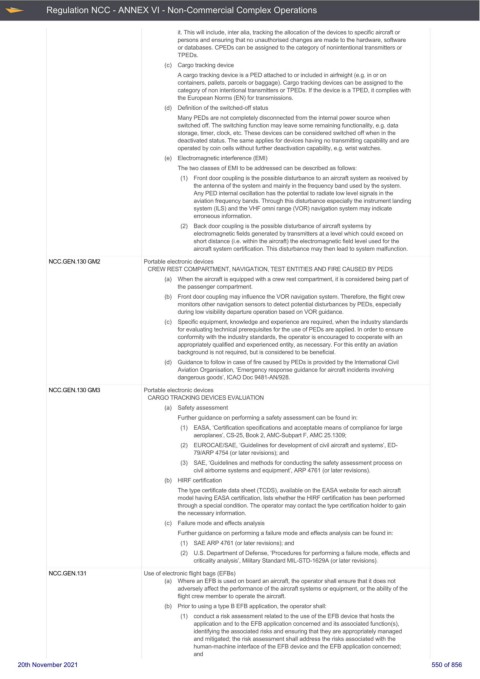Page 550 - UK Air Operations Regulations 201121
P. 550
~
~ Regulation NCC - ANNEX VI - Non-Commercial Complex Operations Centrik
it. This will include, inter alia, tracking the allocation of the devices to specific aircraft or
persons and ensuring that no unauthorised changes are made to the hardware, software
or databases. CPEDs can be assigned to the category of nonintentional transmitters or
TPEDs.
(c) Cargo tracking device
A cargo tracking device is a PED attached to or included in airfreight (e.g. in or on
containers, pallets, parcels or baggage). Cargo tracking devices can be assigned to the
category of non intentional transmitters or TPEDs. If the device is a TPED, it complies with
the European Norms (EN) for transmissions.
(d) Definition of the switched-off status
Many PEDs are not completely disconnected from the internal power source when
switched off. The switching function may leave some remaining functionality, e.g. data
storage, timer, clock, etc. These devices can be considered switched off when in the
deactivated status. The same applies for devices having no transmitting capability and are
operated by coin cells without further deactivation capability, e.g. wrist watches.
(e) Electromagnetic interference (EMI)
The two classes of EMI to be addressed can be described as follows:
(1) Front door coupling is the possible disturbance to an aircraft system as received by
the antenna of the system and mainly in the frequency band used by the system.
Any PED internal oscillation has the potential to radiate low level signals in the
aviation frequency bands. Through this disturbance especially the instrument landing
system (ILS) and the VHF omni range (VOR) navigation system may indicate
erroneous information.
(2) Back door coupling is the possible disturbance of aircraft systems by
electromagnetic fields generated by transmitters at a level which could exceed on
short distance (i.e. within the aircraft) the electromagnetic field level used for the
aircraft system certification. This disturbance may then lead to system malfunction.
NCC.GEN.130 GM2 Portable electronic devices
CREW REST COMPARTMENT, NAVIGATION, TEST ENTITIES AND FIRE CAUSED BY PEDS
(a) When the aircraft is equipped with a crew rest compartment, it is considered being part of
the passenger compartment.
(b) Front door coupling may influence the VOR navigation system. Therefore, the flight crew
monitors other navigation sensors to detect potential disturbances by PEDs, especially
during low visibility departure operation based on VOR guidance.
(c) Specific equipment, knowledge and experience are required, when the industry standards
for evaluating technical prerequisites for the use of PEDs are applied. In order to ensure
conformity with the industry standards, the operator is encouraged to cooperate with an
appropriately qualified and experienced entity, as necessary. For this entity an aviation
background is not required, but is considered to be beneficial.
(d) Guidance to follow in case of fire caused by PEDs is provided by the International Civil
Aviation Organisation, ‘Emergency response guidance for aircraft incidents involving
dangerous goods’, ICAO Doc 9481-AN/928.
NCC.GEN.130 GM3 Portable electronic devices
CARGO TRACKING DEVICES EVALUATION
(a) Safety assessment
Further guidance on performing a safety assessment can be found in:
(1) EASA, ‘Certification specifications and acceptable means of compliance for large
aeroplanes’, CS-25, Book 2, AMC-Subpart F, AMC 25.1309;
(2) EUROCAE/SAE, ‘Guidelines for development of civil aircraft and systems’, ED-
79/ARP 4754 (or later revisions); and
(3) SAE, ‘Guidelines and methods for conducting the safety assessment process on
civil airborne systems and equipment’, ARP 4761 (or later revisions).
(b) HIRF certification
The type certificate data sheet (TCDS), available on the EASA website for each aircraft
model having EASA certification, lists whether the HIRF certification has been performed
through a special condition. The operator may contact the type certification holder to gain
the necessary information.
(c) Failure mode and effects analysis
Further guidance on performing a failure mode and effects analysis can be found in:
(1) SAE ARP 4761 (or later revisions); and
(2) U.S. Department of Defense, ‘Procedures for performing a failure mode, effects and
criticality analysis’, Military Standard MIL-STD-1629A (or later revisions).
NCC.GEN.131 Use of electronic flight bags (EFBs)
(a) Where an EFB is used on board an aircraft, the operator shall ensure that it does not
adversely affect the performance of the aircraft systems or equipment, or the ability of the
flight crew member to operate the aircraft.
(b) Prior to using a type B EFB application, the operator shall:
(1) conduct a risk assessment related to the use of the EFB device that hosts the
application and to the EFB application concerned and its associated function(s),
identifying the associated risks and ensuring that they are appropriately managed
and mitigated; the risk assessment shall address the risks associated with the
human-machine interface of the EFB device and the EFB application concerned;
and
20th November 2021 550 of 856

